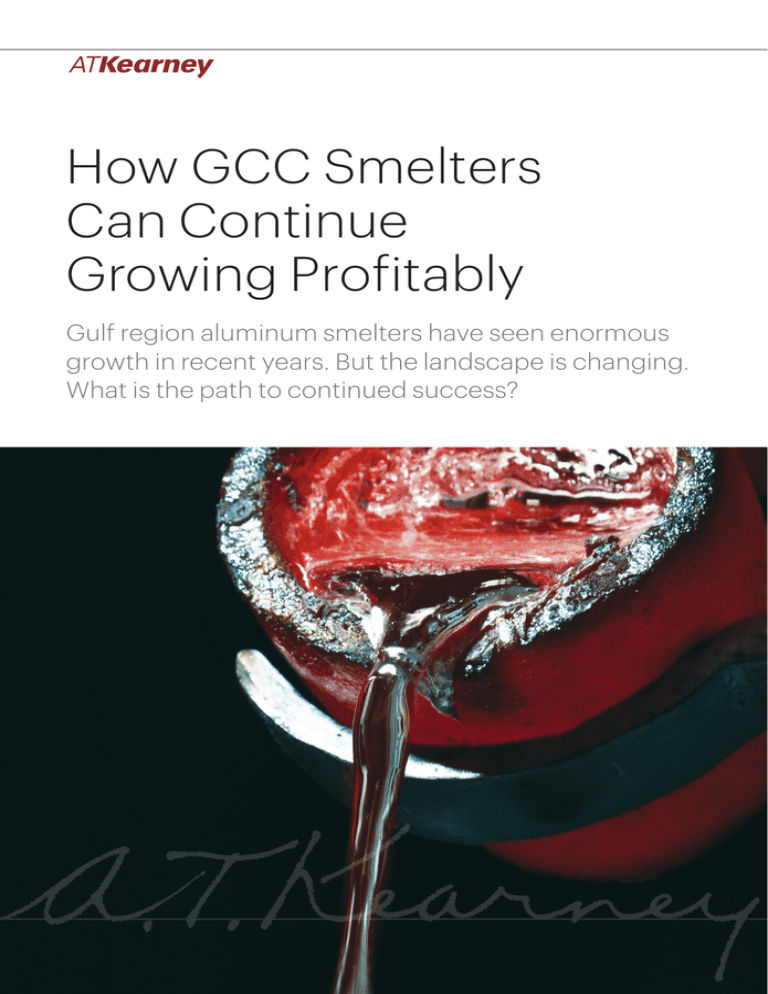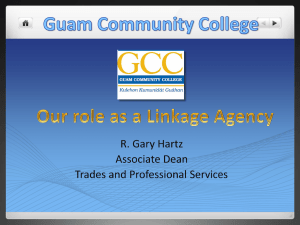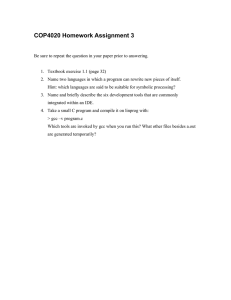
How GCC Smelters
Can Continue
Growing Profitably
Gulf region aluminum smelters have seen enormous
growth in recent years. But the landscape is changing.
What is the path to continued success?
How GCC Smelters Can Continue Growing Profitably
1
The aluminum market is booming in Gulf Cooperation Council (GCC) countries. Smelters
have grown an average of 8.3 percent per year since 2005, thanks to energy cost advantages,
capacity increases, and government support. Utilization rates have topped 90 percent as
aluminum—lightweight, conductive, anti-corrosive—has become the material of choice for
industries ranging from transportation to packaging to construction.
And the growth will continue. Aluminum consumption is expected to rise 5 percent annually
through the end of the decade, reaching 67 million tons per year by 2020 (see figure 1). Supply
is keeping pace with demand, with additional capacity announced for the near future. More
than 80 percent of this capacity will be concentrated in the GCC, India, and China, adding
further pressure to smelting margins in North America and Europe.
Figure 1
Global aluminum demand is growing steadily, spurred by growth in India and China
Global aluminum consumption
Million tons per annum
CAGR
2010–2020
66.7
Rest of the world
5.6
2.0%
2.1%
2.1%
1.0%
8.1
1.0%
Europe
3.7
7.9%
India
1.5
5.1%
8.2
53.0
1.4
7.4
40.4
1.2
31.6
0.9
6.1
1.3
6.9
6.4
1.9
5.1
5.3
Latin America
Unted States and Canada
China
7.7
2.7
7.3
37.3
1.7
8.3%
26.4
8.3
1.0
2.1
2.3
Middle East and rest of Asia
16.8
7.1
2005
2010
2015
2020e
Note: Latin America includes Brazil and Venezuela. Middle East and rest of Asia includes Bahrain and UAE. Europe includes Germany, France,
Norway, and Iceland. The rest of the world includes Africa and Oceania.
Sources: RBC—Aluminum Market Outlook; U.S. Geological Survey Minerals Yearbook; CRISIL; A.T. Kearney analysis
Still a range of additional challenges looms for GCC smelters: a more self-sufficient China,
upstream mining taking more power along the value chain, and limited access to skilled
labor. How can GCC aluminum smelters navigate the coming years to maintain a long-term
competitive advantage?
The GCC’s Smelting Advantage
In addition to strong government backing, GCC aluminum smelters have three main advantages
over competitors in other regions:
Cheap energy. With roughly one-third of the total cost of refining and production in energy,
electricity costs can provide a competitive edge. GCC electricity costs are significantly lower
How GCC Smelters Can Continue Growing Profitably
2
than other producing regions, so GCC smelters begin with a profitability advantage (see figure 2).
Whether or not this advantage continues over the longer term remains a question. Cheap energy
is not universally available in the GCC region and is becoming scarce as other industries, such as
petrochemicals, make ambitious expansion plans. The advent of shale gas in North America and
its impact on U.S. energy costs could further alter the dynamics of the global market.
Figure 2
The low cost of energy fuels the GCC’s cost advantages in aluminum
Aluminum cost structure
100%
Electricity cost per ton
US$ (2011)
8%
8%
788
China
13%
473
Europe
456
Latin America
32%
430
Asia
357
North America
339
Russia
335
Australia
39%
Gulf Cooperation Council
316
302
Africa
World average
Alumina
Electricity
Carbon
Labor
Others
Sources: International Energy Agency; CRU Aluminium Cost Service; Rio Tinto Alcan; CRU; Alcoa; A.T. Kearney analysis
Scale and world-class infrastructure. GCC smelters, with an average capacity of 734 kilotons
per year, are typically three times larger than their counterparts in other regions. This lowers
operational costs per unit of production. Gulf Aluminum Council (GAC) General Secretary
Mahmood Daylami expects GCC players to double their capacity by 2020, which further
increases their size and scale advantage (see figure 3 on page 4).1
Gulf smelters also enjoy modern, world-class port infrastructures, a major cost and time-todelivery advantage in the European market compared with China and India. For example,
the shipping time from the GCC to Europe is only 12 days, compared to 30 days from India
and 45 days from China.
State-of-the-art technology. GCC smelters have developed some of the latest smelting
technology—improving productivity and increasing output per cell and therefore overall
capacity—while reducing metal consumption levels and emissions. For example, Dubal’s
proprietary DX+ technology averages 3,290 kilograms per day of output metal per cell, more
than double the output of its previous technology. New smelters, such as the up-and-coming
Ma’aden, use high-amperage-cells technology to reduce capital and operating costs and
improve overall efficiency. Alba and other established smelters are also improving the efficiency
of their older assets, such as those used to generate power.
A.T. Kearney interview with Mahmood Daylami, February 2013
1
How GCC Smelters Can Continue Growing Profitably
3
Figure 3
Installed capacity in the Gulf region will almost double by 2020
Primary aluminum capacity in the GCC
(Kilometric tons per year)
7,000
340
1,700
3,330
+91%
1,290
3,670
Capacity
2012
3,670
Capacity under
construction
(2013-2014)
Announced projects
under evaluation
(2014-2020)
Tentative
capacity
Estimated
capacity 2020
Note: GCC is the Gulf Cooperation Council.
Sources: Company announcements; Zawya; MEED; Gulf Aluminum Council (GAC); interview with GAC General Secretary Mahmood Daylami;
A.T. Kearney analysis
Challenges on the Horizon
Despite these advantages, several challenges loom in the near future.
China’s increasing self-sufficiency. What happens as China, the world’s number-one aluminum
consumer, increases its capacity? It becomes more self-sufficient and overall addressable global
demand—that is, demand excluding China—slows down considerably (see figure 4).
Figure 4
If China succeeds in becoming self-sufficient, overall global demand for aluminum
will slow down considerably
Global aluminum consumption
(Indexed: 2010 = 100)
CAGR
200
150
Global demand
including China
5.1%
100
Global demand
excluding China
1.4%
50
0
2010
2015e
2020e
Source: A.T. Kearney analysis
How GCC Smelters Can Continue Growing Profitably
4
Vertical integration. Access to raw materials, especially bauxite, is becoming an important
issue for GCC aluminum producers that are heavily focused on smelting. Mining companies
are strengthening their positions and their bargaining power. The top five bauxite miners
control 41 percent of overall production and 53 percent of alumina refining. As more miners,
such as Rio Tinto, move into smelting the share of freely traded bauxite and alumina has fallen;
as their prices decouple from the London Metal Exchange it threatens standalone smelters’
profitability and ability to continue operations uninterrupted.
GCC smelters need to secure access to critical raw materials such as coke and bauxite either
through acquisitions or long-term deals. Abu Dhabi’s Mubadala recently signed a long-term
bauxite supply agreement with Guinea-based Compagnie des Bauxites de Guinée (CBG).
Labor. Access to skilled labor is a major issue for many industries across the GCC. According
to findings in our recent A.T. Kearney Assessment of Excellence in Procurement in the Gulf,
40 percent of participants struggle to find the skills they need. With skilled labor necessary
for the aluminum sector to achieve its ambitious expansion targets and help further diversify
the GCC away from crude oil, the challenge is to develop the necessary skills locally and
control the costs of expatriate labor.
How can GCC aluminum smelters
navigate the coming years to maintain
a long-term competitive advantage?
Succeeding in an Uncertain Future
In light of these challenges, GCC smelters have many options available to make both
an immediate impact on results while creating long-term profitable growth and
operational stability.
The short-term moves include:
S&OP. Improving the sales and operations planning (S&OP) process can save 8 to 12 percent in
logistics costs and 25 to 35 percent in inventory costs. Customers will appreciate the reliability
and lead times that are as much as 50 percent shorter.
Assets and maintenance. Integrating condition monitoring, non-destructive testing,
preventive and predictive maintenance, and work orders can cut maintenance costs by as
much as 30 percent after one cycle and another 20 percent or more after two cycles.
Procurement. Procurement optimization can save up to 15 percent in all major categories,
mainly by hedging strategic raw materials and increasing collaboration with suppliers.
A.T. Kearney’s Purchasing Chessboard® framework helps identify the right sourcing strategies
for each spend category.2
Support processes. Streamlining processes and creating shared services can save up to
20 percent in general and administrative costs.
See the A.T. Kearney Purchasing Chessboard at www.atkearney.com.
2
How GCC Smelters Can Continue Growing Profitably
5
Areas to create a growing, long-term advantage include:
Value-added downstream products. The aluminum value chain includes mining, refining,
and smelting in its upstream market, and rolling, extruding, casting, and transformation and
distribution downstream (see figure 5). GCC smelters have traditionally focused their energies
upstream, taking advantage of cheap energy to produce higher volumes and profits. Most
currently planned large expansion projects follow this “toll model.” But there’s a limit to how
much aluminum capacity Gulf region smelters can install affordably as competition for natural
gas increases and environmental concerns play a larger role in the public debate. While
margins in this model are traditionally high, volatility is growing, and with market forces
dictating aluminum prices, smelters will have to keep costs down.
Figure 5
In the aluminum value chain, GCC smelters
Upstream
Downstream
Cheap
energy
Packaging
Trade
Bauxite
Mining
Refining
Trade
Smelting
Trade
GCC positioning
Input
Processing
Transaction
Rolling
Transformation
and distribution
Building
Extruding
Transformation
and distribution
Transport
Casting
Transformation
and distribution
Engineering
Others
Source: A.T. Kearney analysis
Value-added downstream products could provide the next major competitive advantage. Demand
for castings, extrusions, rolled product fabrications, and finished items is rising, particularly in the
auto, transportation, construction, packaging, power, and consumer goods industries.
Demand for these products is accelerating across the Middle East and North Africa (MENA),
with 8 percent growth expected. The GAC’s Daylami notes that demand for downstream
aluminum from the GCC’s construction, automotive, rail, aviation, and power generation
industries could ramp up even more in coming years. Additionally, downstream aluminum,
a differentiated business with a focus on R&D and customers, has steadier margins than
capital-intensive, commodity-based upstream aluminum.
The cost base. GCC smelters need to keep a watchful eye on costs. While most have focused
on expansion, where capital expenditures (capex), operational readiness, and reaching steady
state are the main issues, now the attention turns to managing daily operations and containing
operational expenses (opex). Cost reduction programs, starting with reviews of SG&A spending,
logistics, infrastructure, and spare parts management, will become crucial as competition for
natural gas ramps up and feedstock in the region becomes scarcer.3 Co-locating smelting with
the downstream industry is another way to reduce costs, by eliminating the need for expensive
process steps, such as cooling, transportation, and re-melting.
SG&A is selling, general, and administrative.
3
How GCC Smelters Can Continue Growing Profitably
6
Regional cooperation. The GCC is already an aluminum powerhouse, and its smelters are working
well through the GAC to share best practices and reduce costs. The new spent pot linings (SPL)
recycling plant in the United Arab Emirates, which will treat the waste from all GCC smelters, is
a good example of such cooperation.
Further cooperation opportunities include short-term moves such as joint logistics and
warehouses, the sharing of maintenance best practices, and talent development to long-term
actions such as joint plants, co-sourcing of spare parts, alumina, and coke, and promoting
recycling to increase the secondary market. And for GCC smelters that pursue the value-added
model in downstream products mentioned earlier—whether by setting up new companies or
by acquiring stakes in existing ventures—coordination with GCC governments will ensure that
excessive competition does not diminish the business’s underlying attractiveness (as is occurring
in the race to attract tenants to many GCC region industrial zones).
A Unique Position
GCC smelters face many challenges, but a feedstock advantage and world-class assets provide
a unique opportunity to overcome them. By taking the steps outlined in this paper, smelters
have an opportunity to capture a long-term competitive advantage.
Authors
Dan Starta, partner, Shanghai
dan.starta@atkearney.com
Abhishek Poddar, partner, India
abhishek.poddar@atkearney.com
Jose Alberich,
partner, Middle East and Madrid
jose.alberich@atkearney.com
The authors wish to thank GAC General Secretary Mahmood Daylami and their colleague Andreea Zugravu for their
valuable contributions to this paper.
How GCC Smelters Can Continue Growing Profitably
7
A.T. Kearney is a global team of forward-thinking partners that delivers immediate
impact and growing advantage for its clients. We are passionate problem solvers
who excel in collaborating across borders to co-create and realize elegantly simple,
practical, and sustainable results. Since 1926, we have been trusted advisors on the
most mission-critical issues to the world’s leading organizations across all major
industries and service sectors. A.T. Kearney has 57 offices located in major business
centers across 39 countries.
Americas
Atlanta
Calgary
Chicago
Dallas
Detroit
Houston
Mexico City
New York
San Francisco
São Paulo
Toronto
Washington, D.C.
Asia Pacific
Bangkok
Beijing
Hong Kong
Jakarta
Kuala Lumpur
Melbourne
Mumbai
New Delhi
Seoul
Shanghai
Singapore
Sydney
Tokyo
Europe
Amsterdam
Berlin
Brussels
Bucharest
Budapest
Copenhagen
Düsseldorf
Frankfurt
Helsinki
Istanbul
Kiev
Lisbon
Ljubljana
London
Madrid
Milan
Moscow
Munich
Oslo
Paris
Prague
Rome
Stockholm
Stuttgart
Vienna
Warsaw
Zurich
Middle East
and Africa
Abu Dhabi
Dubai
Johannesburg
Manama
Riyadh
For more information, permission to reprint or translate this work, and all other correspondence,
please email: insight@atkearney.com.
A.T. Kearney Korea LLC is a separate and
independent legal entity operating under
the A.T. Kearney name in Korea.
© 2013, A.T. Kearney, Inc. All rights reserved.
The signature of our namesake and founder, Andrew Thomas Kearney, on the cover of this
document represents our pledge to live the values he instilled in our firm and uphold his
commitment to ensuring “essential rightness” in all that we do.


